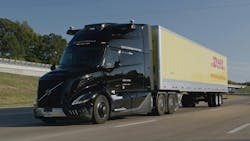Volvo Trucks Begin Autonomous Trial in Texas
Volvo Autonomous Solutions (V.A.S.) and DHL Supply Chain have taken a step toward autonomous freight transportation with the launch of autonomous operations in the United States. The operations will be enabled by the Volvo VNL Autonomous, which is powered by the Aurora Driver.
The partnership aims to assist in validating the full ecosystem required for autonomous transport at scale, according to Volvo. At this stage, a safety driver will be present to monitor performance and ensure integration into existing logistic networks. Freight will initially be hauled on two lanes, Dallas to Houston and Fort Worth to El Paso.
The Volvo VNL Autonomous is designed with built-in redundancy for critical systems. In autonomous trucks, redundancy replaces the backup provided by a human driver with systems that can automatically take control in the rare case of primary systems encountering an issue, ensuring safe operations.
Mentioned in this article
- The latest on technology
- Volvo debut's VNL Autonomous
- Volvo, Aurora partner on autonomous trucks
- The latest on safety and security
This safety approach is further strengthened by Volvo’s close partnership with Aurora, whose technology enables the Volvo VNL Autonomous to safely navigate the world around it. The Aurora Driver is equipped with sensors, including high-resolution cameras, imaging radar, and proprietary long-range lidar that allow for safe autonomous operations at highway speeds.
To ensure uptime for future autonomous fleets, V.A.S. has leveraged the industry and transport knowledge of key Volvo Trucks’ dealers across Texas to establish critical support and service points for the Volvo VNL Autonomous.
“Autonomous trucks can also offer drivers new opportunities, such as remote monitoring and management of fleets while also addressing ongoing labor challenges,” said Jim Monkmeyer, president of transportation for DHL Supply Chain North America, in a statement. “Additionally, autonomous trucks can reduce the physical and mental strain on drivers, leading to improved quality of life and increased job satisfaction.”
About the Author
Harlee Hewitt
Harlee is a former associate editor for Construction Equipment.
